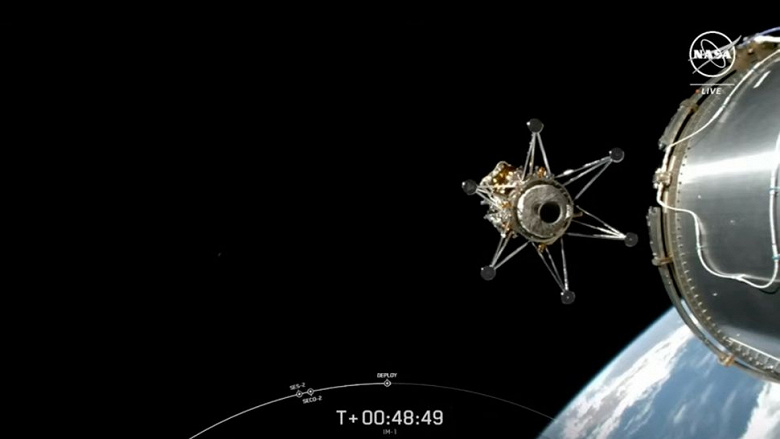Intuitive Machines takes over the baton in efforts to reach the Moon and collect data for NASA's Artemis program
«Odyssey», a robotic lunar lander developed by Intuitive Machines, successfully launched today from KSC Pad 39A on a SpaceX Falcon 9 rocket at 1:05 a.m. ET (06:05 Greenwich Mean Time). Falcon 9's first stage returned to Cape Canaveral in 7.5 minutes.
The IM-1 mission, within which the Odyssey is launched, involves its landing near the south pole of the Moon. According to the mission plan, after reaching lunar orbit, «Odysseus». will begin its historic mission — landing in the ancient impact crater Malapert, which is located approximately 300 kilometers from the south pole of the Moon. It is expected that «Odysseus» will reach the target on February 22.
Total weight «Odyssey» is 675 kilograms. It is equipped with six NASA instruments installed on board under a contract worth $118,000,000. An additional $11,000,000 was spent on the development and creation of scientific equipment.
The equipment list looks like this:
- ROLSES — a radio observation device for the photoelectronic shell of the lunar surface. Will study the electron plasma and radio environment near the IM-1 landing site. These data have implications for understanding the environment on the Moon.
- LRA — Laser Retro-Reflector Array. It is a collection of small reflectors that will serve as guides for future lunar landing missions. They will help ensure the accuracy of the lunar landing of spacecraft.
- NDL — navigation Doppler lidar for accurate speed and range measurement «Odyssey» during landing.
- SCALPSS — stereo cameras for exploring the lunar surface. The instrument will study the interaction of the module's exhaust plume with the lunar surface, collecting data that will help in the design of future Artemis landers.
- LN-1 — lunar navigator. It is a small radio navigation beacon for autonomous positioning of a spacecraft.
- RFMG — A radio frequency mass meter that uses radio waves to measure the remaining fuel in the Odyssey's tank, a challenging task in microgravity.
Also on board «Odyssey» contains commercial cargo for a variety of clients, including Columbia Sportswear and sculptures by artist Jeff Koons, and a container called Lunar Safe Storage, which is designed to protect humanity's accumulated knowledge in the event of a disaster on Earth. Embry-Riddle Aeronautical University students developed EagleCam — camera system that will be installed on the «Odyssey» and will try to capture the descent of the lander.
Mission IM-1 — part of the CLPS program, which aims to use privately owned American robotic landers to carry scientific equipment to the Moon. This will allow NASA to more cost-effectively deliver data collection instruments that will be useful as part of the Artemis program, the main goal of which — creation of a habitable base at the south pole of the Moon by the end of the 2020s. This region is believed to contain water ice that could be used to provide water for astronauts and to produce rocket fuel.
IM-1 is not the first attempt by CLPS to reach the Moon. Astrobotic's Peregrine lander launched on January 8, lifting off on the debut mission of United Launch Alliance's Vulcan Centaur rocket. This launch went well, but shortly after launch the Peregrine suffered a fuel leak. On January 18, the lunar probe made a controlled entry into the Earth's atmosphere.

